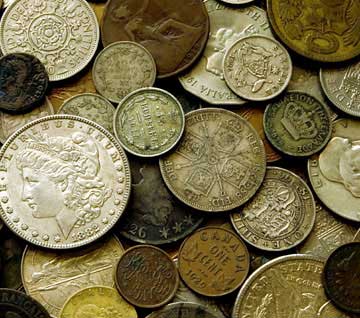From the blog
Coins and Loose Change (May 11, 2015)

This article is designed to provide a brief overview coin values. As always your situation and collection may be more valuable than indicated in this article. Thus it is suggested that you get your collection evaluated before you take action.
Many seniors do not realize that their old coin collection or stash of old coins are worth far more than face value. Any dollar, half dollar, quarter or dime minted before 1964 is silver. The general value of these coins are at current silver prices (August 10, 2013) as follows:
A silver dollar about $16.00 to $20.00, half dollar about 6.50, quarter about $3.00 and a dime about $1.00. Yes, a measly silver dime minted 1964 and before is worth a whole dollar. Now here is a fact most people do not know the 1942-1945 war nickels are silver and worth about .65 cents. Another interesting fact the Kennedy half dollars from 1965 to 1970 are 40% silver and worth about $2 each. When one of your elderly family members or a client mentions getting rid of some old coins make sure they know if they just take their silver coins down to the bank they get face value, not silver value. In fact many tellers will gladly take in the quarters and replace the silver coins with their money and benefit from the senior’s lack of knowledge. I just met with an elderly lady who had brought her old silver dollars down to the bank the teller told her they were not worth anything more than a dollar. The teller worked very hard to get her to deposit the dollars with the bank, but she did not do so because she felt something was wrong.
Mint marks and dates: Some of the old coins are worth far more than silver or gold value. Why? Because they are in uncirculated or near uncirculated condition. An average silver coin in pristine condition commands a premium. How much depends on scarcity, date minted and where it was minted (also known as mint mark). Today many dealers prefer to get the coin graded and once graded it increases the value of the coin if it grades well and makes it easier to sell. Selling a rare silver coin for silver value when it could be worth 10 times that silver value or more makes no sense.
Gold coins: Here is where the value really goes up. There are a variety of US circulated minted gold coins, and of course many countries have minted gold coins for investment purposes including the American Eagle, Krugerrand, Canadian maple leaf, etc. The US has minted gold coins in $20, $10, $5, $2.50 and $1 denominations for circulation. An average $20 US gold piece could be worth $1,100 or more.
Other old coins: There are lots of interesting US coins. Such as the Indian head penny which is generally worth about 40 cents, unless it is rare, or a buffalo nickel which is worth about 20 cents. There are also the 2 cent copper coins minted from 1964 to 1873. Worth about $5.50 or so. There are also three cent pieces minted from 1851 to 1873, some are silver and some are nickel. Silver three cent pieces are worth about $15 each, and nickel maybe $5.50 each. Rare coins are of course worth more. Some of the old US coins may look foreign because they are unfamiliar to you so before you sell any old coins have someone who is not buying them identify them and provide values.
Foreign coins: Generally the same rules apply to foreign coins: silver and gold are worth more. Date mint mark and condition matter. There are fewer collectors of foreign coins in the US so the prices will be a bit reserved.
Selling your old coins: Now this is the tough part. The people who generally know the most about coins are coin dealers and they are likely to tell you what they want to pay for the coins, not what they are really worth. And they will never suggest sending the coin to auction. You can pay someone such as myself to come out and appraise the value of your coin collection and advise you what your liquidation options are. You can also go to three coin dealers and get three offers- which I always suggest people do on anything they wish to sell to dealers. You can also choose to have an estate liquidator like myself who does not buy be your selling agent. They generally charge 15% commission for this service. The advantage to the client in using a professional estate liquidator is that they often get special pricing from the buyers because they sell so much silver and gold. That may be 10 to 15% above that which is offered to the average customer and thus the buyer often pays the estate liquidator commission. Valuable rare coins should always be sold at auction, just like antiques to maximize the return. A local general auction house is not the correct venue for sale of valuable coins. They should always be sold at auction houses which specialize in coins.

